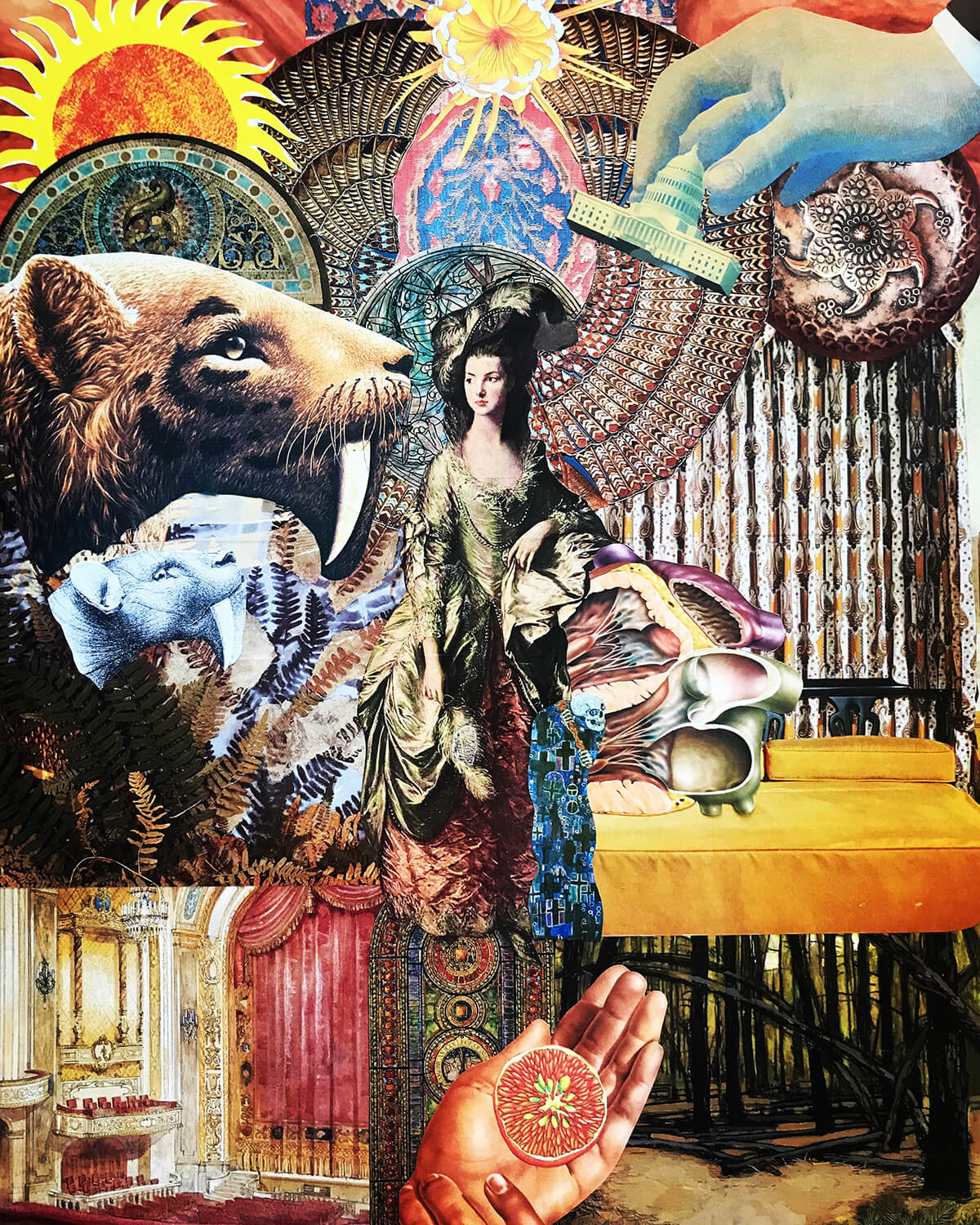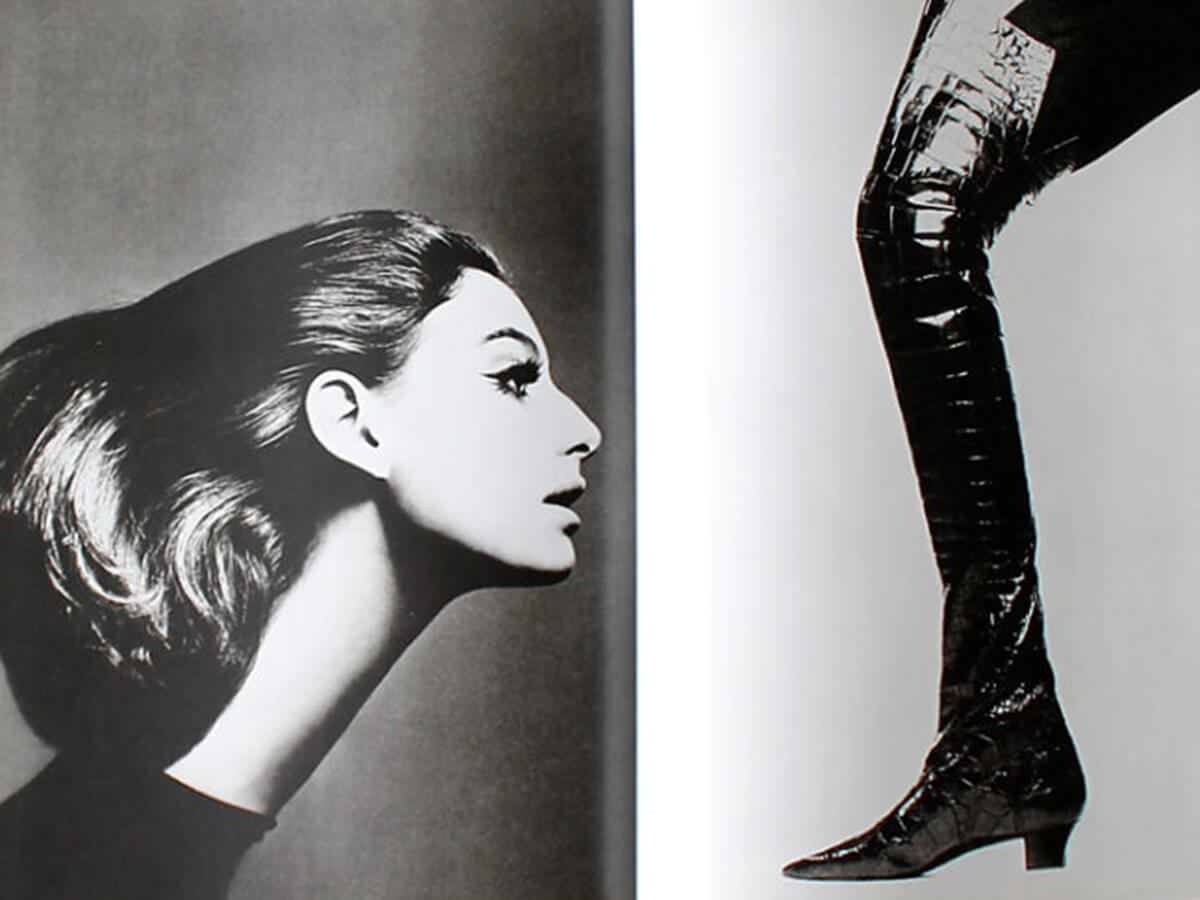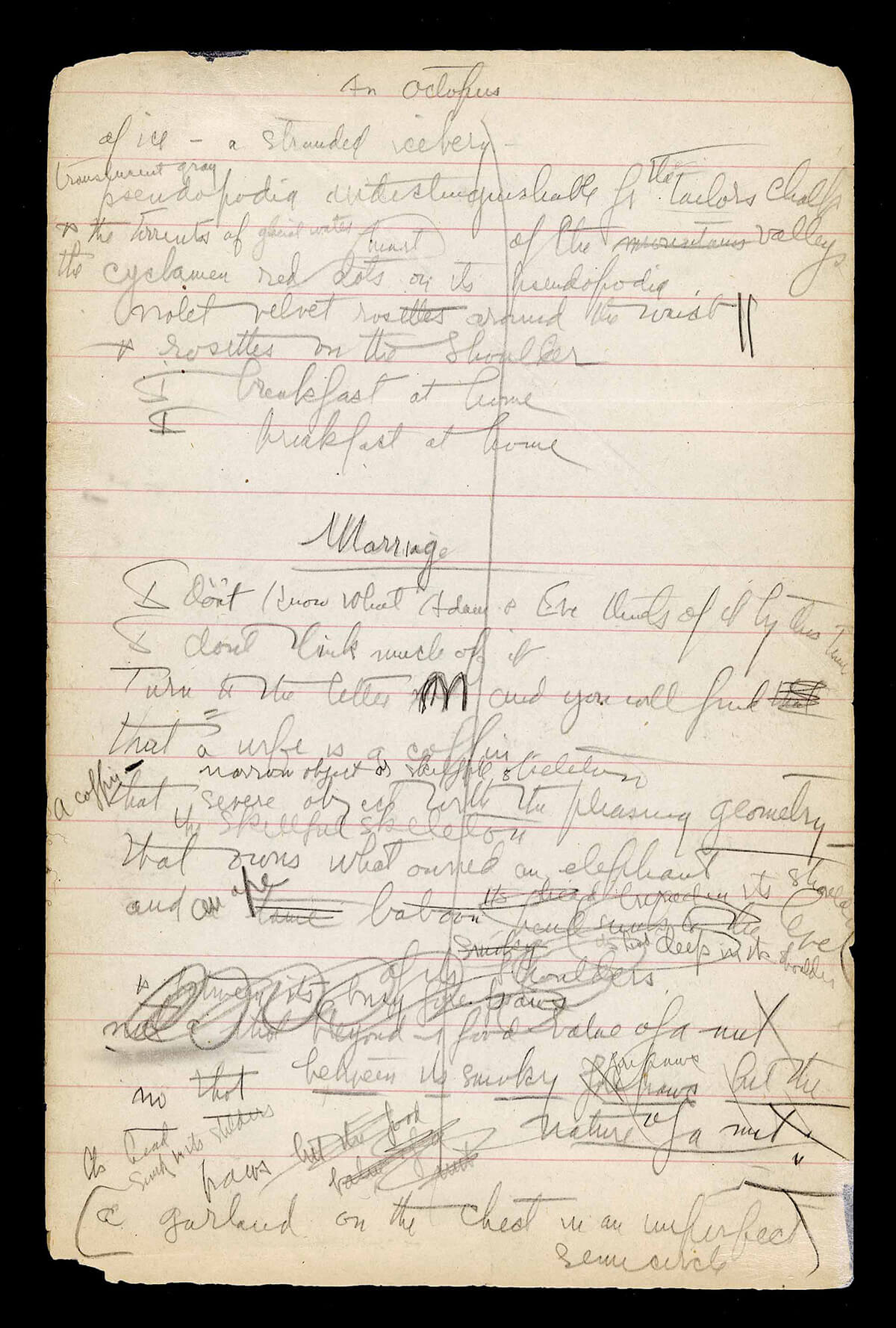Potpourri
Alice Bolin
February 11, 2019

When I was twenty I lived in a studio apartment near downtown Lincoln, Nebraska. Rent was $350, and it had shag carpet and a window that faced a gas station parking lot and beyond that, the courthouse. I had piles of magazines: Us Weekly, Vogue, Teen Vogue, W, Glamour, Jane, Vanity Fair, Harper’s, Zoetrope, Poetry, The Believer. I read—read, not looked at—all of them from cover to cover each month (or in the case of Us Weekly, each week), and some I read twice.
But when I had two of the same magazine (this was often the case), and when I was done with the tabloids, and when I was done with the three different newspapers that contained the three different crossword puzzles I did each day, and when I stole Neiman Marcus catalogues from my grandma, I would make abstract collages on composition books, which I would then fill with poetry, grocery lists, resolutions, recriminations, and long passages from library books that I painstakingly copied by hand.
My collages were often made from tiny circles or leaf shapes that I cut into several pages at once, letting chance dictate the text or faces or textures that would cover the notebooks in a pattern like feathers or sequins. Then I would put something in the foreground, like a face from a Roy Lichtenstein calendar or a picture of the Creature from the Black Lagoon, sometimes framed in concentric rings like a Byzantine halo. My method varied, though. On one notebook I pasted jagged scraps of newspaper and words cut at random from magazine headlines: a ransom note with no message.
This was a few months before I left Lincoln to do my MFA in poetry, but I knew even then that I made poetry and collage for the same reasons, or at least that strange, playful, dramatic people made both. Poetry and collage have been aligned at least since the Surrealists, who loved getting drunk and making either visual or verbal Exquisite Corpses, in a collaborative spirit that heralded the death of the author before Barthes eulogized him. They believed in a sleepwalking self-ruled by a scrapheap of unconscious longings and useless memories.
My friends Brent and Karyna caught some sort of collage mania in the past year. Their apartment is now plastered with their mixed media fantasias made from ‘80s decorating books, scary children’s books, hipster art magazines, Newsweeks and National Geographics. Karyna’s collages are rococo creations obsessed with cartoon animals, starlets of the studio era, naked people from renaissance paintings, intricate landscapes, and pictures of flowers and fruit. Brent’s are simpler (he often doesn’t even glue them down), combining a few disparate textures.
They make them in ecstatic late night sessions or sitting in front of the TV at spare moments, pretty much purely for fun. Karyna is a well-known poet associated with the Gurlesque, a movement of women writing femininity as exaggerated, garish, comic, dirty, and macabre. I loved Karyna’s poems long before I met her because they were theatrical, dark, and delightful. Her collages would seem have a different place in her life than her poetry—a craft, maybe, as opposed to an art?—but I gain such pleasure from them, for something approaching the same reasons.
*
I’ve recently become fixated on Diana Vreeland’s 1980 coffee table scrapbook Allure. The book is a collection of formative images from photographers like Baron de Meyer, Edward Steichen, Man Ray, Irving Penn, and Richard Avedon, from both Vreeland’s childhood infatuation with fashion magazines and her four legendary decades (starting in 1932) editing Harper’s Bazaar and Vogue. But Allure is not just a book of fashion photography. It also includes paparazzi photos of Maria Callas and Greta Garbo. It includes pictures from George IV’s coronation and his funeral. Portraits of Charles de Gaulle, Gertrude Stein, and Evita Peron on her deathbed. Brigitte Bardot and Mick Jagger. (Vreeland: “Her lips made Mick Jagger’s lips possible.”) “This is a potpourri which I chose to amuse and perhaps please the reader,” Vreeland writes in her three-sentence introduction to the book, providing characteristically little insight into her creative choices. She was always more interested in gestures and flourishes than explanations.

The glorious discord of these images (Vreeland: “What this book needs is some more dis-unity!”) is a virtuoso performance of the magazine editor’s subtle art. One striking page of Allure is a grainy image of a Japanese runway model in futuristic sunglasses taken from Vogue, where it had only been included as a tiny snapshot. “My immediate instinct is to want to blow it up—make it big! It can’t look as if it’s been taken out of a silver frame! You’ve got to make something out of it.” Vreeland says of the photograph. (Her captions were selected by her co-writer Christopher Hemphill from hours of taped conversations.) When I read that I realized something that might be obvious, but that had never occurred to me: magazines are collages, some of our culture’s most beautiful and effective ones.
This is one reason Allure has blown my mind: it serves as a not-so-missing link between magazine collecting and collage, two activities that always seemed opposed to me, since one preserves and the other destroys. Fashion magazines, in their artful disjunction, cheeky juxtapositions, and surreal depictions of the human body, serve as art collages’ raw material and target of parody and stylistic blueprint all in one. And Vreeland, the most visionary fashion editor of the twentieth century, did more to dictate the frenetic style of the fashion spread than anyone else. The same disjunction, juxtaposition, and surrealism that are now the rule may have originated in Vreeland’s visual preoccupations.
Hemphill included in Allure a five-page introduction called “Notes on a Collaboration,” such a thorough preamble that Vreeland’s own tiny introduction, printed directly after Hemphill’s, reads like a punchline. In it, he describes many of the touchstones of Vreeland’s collagist instinct. He writes how she learned from the art director at Harper’s Bazaar “to oppose two pictures—a ‘spread’—of contrasting scale and form. She had also learned rhythmic variations of scale and form in the sequence of pages.” She was a master of these rhythms. In this the magazine spread formally resembles not only collage but its cousin, the montage: a film sequence cut from disparate scenes, guided by a logic flowing as much from the visual and instinctual as from the narrative.
Cutting is the basic activity of collage, but it is also a central metaphor of so much twentieth-century aesthetics, with film as a prime example. (Brent and Karyna call their piles of ready-to-collage pieces “cuts.”) Vreeland was mad for cutting, famously playing paper dolls with photographs for Harper’s Bazaar and Vogue, making idealized composites from different models’ heads, torsos, limbs. “At Vogue… I really went to town!” she says. “I put legs and arms and heads and everything else together… to give the perfect whole.”
These quotes are wittily juxtaposed in Allure with graphic photos of a woman having eye-lift surgery, which Vreeland commissioned for Vogue in the 1960s but was never able to publish. All of these cuts, the medical and the editorial, seem in service to the same postmodern pragmatism, an allegiance more to artifice than art. I think my allegiance is elsewhere, but this is where things get confusing. Film and fashion are prime examples of modernity’s slippage between art and commerce, a productive ambiguity that birthed figures as disparate as Andy Warhol and Walt Disney. (Vreeland: “Listen, photographers aren’t artists, for goodness sake!”)
Put cynically: purity in contemporary art is a luxury, originality an impossibility, and many more of us comment than create. But Vreeland and Hemphill (who once worked for Warhol, not at all coincidentally) appear to be free of these anxieties about their achievement in Allure. “Mrs. Vreeland often emphasized that we were only re-editing other people’s editing,” Hemphill writes in his introduction, “but in our working and reworking of the material, it became our own.” This seems like a healthy goal for any creative undertaking: revision and re-creation, to make something of our cuts, our scrapbooks, our commonplace books, our dreams.
*
One of my suppositions is that collage is a process of ingestion, in which media creates and presents and recycles images and we respond to these intoxicating images by hoarding and repurposing them. (Magazines are called “digests” after all.) This is both a private, emotional pursuit and a public, rhetorical one. That was true in Vreeland’s case but also for figures who she might have called real artists. I think about the collage poetry of the Modernist poet Marianne Moore, which is woven with quotations from verse, the Bible, book reviews, science and nature magazines, pamphlets, encyclopedias, and overheard conversations.

Many critics have assumed that Moore’s collage aesthetic grew exclusively from her interest in the avant-garde visual artists like the ones she saw at the Armory Show in 1913. But as Bartholomew Brinkman notes in his article “Scrapping Modernism” from Modernism/modernity, there was no collage on display at the Armory Show, and yet her poetry “is still said to be indebted to this (as of yet non-existent) style of collage!” Brinkman’s delicious contention is that although Moore was influenced by artists like Picasso and Braque, her collage poetry flowed organically from her longstanding practice of scrapbooking.
The scrapbook was a Victorian invention, a direct response to the proliferation of print media. Then as now, they were albums for keepsakes and curiosities. And then as now, they were kept mostly by women. Brinkman reads earlier scholars’ neglect of Moore’s scrapbooks as a sexist revisionism in which a homely, feminine practice is effaced by the influence of a swaggering male avant-garde. Moore’s scrapbooks have personal photos and clippings as well as ones with more intellectual or artistic concerns: there are pages with poems clipped from magazines juxtaposed with political cartoons, news items, and photos of tadpoles or John Butler Yeats.
Brinkman’s explanatory reading of these pages is a bit much for me: he interprets a page where a photograph of a man wrestling a shark is pasted above news clippings on the Irish Question as “charged with metaphorical significance,” depicting “violent struggle, just as violent struggle connected an otherwise divided Ireland.” It seems possible, since her scrapbooks were private documents the artistic use of which can only be guessed at, that Moore put the picture of the shark on the page because it fit in an empty space.
I think the connection between her scrapbooks and her poetry is more tentative than that. They might have just been two methods for the autodidact to sift through an excess of digestible media. Moore was consumed with questions of text and truth, so that her poems are often about the ways meaning is made in such a noisy literary environment. “An Octopus,” Moore’s poem about Mt. Rainier, is probably her most famous collage. It patches together quotations from National Parks brochures, figures like John Muir and Ruskin, and a “comment overheard at the circus,” among many other sources. John Ashbery provides a wonderful reading of the technique of the poem, in which Moore literally stages an ascent, “tacking imperturbably among excerpts,” of a mountain of verbal detritus, scaled in order to attempt an original and truthful poetry.
The poems, studded with quotation marks, also seem to purposely draw attention to themselves as drafts or attempts. That’s where public and private scrap collecting intersect: an emphasis on process and an ever-shifting end product. As Brinkman writes of her scrapbooks, “The page is not restricted to a finite set of clippings that produce a limited number of associations; rather, another clipping can always potentially be added in this open-ended accumulation.” Moore’s poems proved as mutable as her sources, and she famously revised them over and over. The cycle of verbal and imagistic consumption begins again, where cuts and quotations and the poet’s own words are all grist for the mill.
I love Moore’s various scraps as exemplifying both literary Modernism—a hyperactive intertextuality and rebellious relationship with literary influence—and a quality of emotional life under modernity, as a new generation of packrats cherished words and images that were made to be disposable. I’m perennially fascinated by the use the audience can make of an artist’s process. What do we learn from the versions and recursions of Moore’s drafts? What do we learn from the way she makes workaday scraps into luminous poetry and in turn treats that poetry like scrap, inverting our ideas of ephemeral and eternal? And when we talk of process, what does a reader gain from the wit and play of the scrapbooks, from that most taboo and unwholesome reason to create: pleasure—or to say it more defiantly—fun?
*
The other famous poet-collagist is the New York School’s John Ashbery, who once called Moore “our greatest modern poet.” Ashbery was one of the most celebrated American poets of the second half of the twentieth century, but his collages have also caused a recent swell of interest, with the 2018 publication of a book of his collages and poems, They Knew What They Wanted and a show at the Tibor de Nagy gallery, both in the year after his death. His collages are cutesy and witty, featuring cut-outs of Caravaggio paintings, pictures of toys, and fetching male catalogue models with their heads cut off. The later works, from the past ten years, are old-fashioned board games randomly pasted with images from turn of the century valentines, loteria cards, and children’s book illustrations.

Ashbery used collage in his poetry too. The poems in his famously difficult second book The Tennis Court Oath collect novelistic scenes, advertising slogans, and random bits of conversation, disintegrating sometimes into random punctuation. He was living in the France at the time that he wrote The Tennis Court Oath, and his isolation from spoken American English made it difficult to put words on paper. “Often I’d visit the American Library and leaf through popular magazines, looking for the tone of voice I felt was lacking,” Ashbery said. “Or I’d buy magazines like Esquire and look through them, copying down random bits of phrases in a sort of collage technique.”
Understanding this makes Ashbery’s most obscure poems so simple to read and enjoy—they perform (and therefore are about) an alienation from one’s native language, and the more general alienation that the language of advertising enacts on all of us. I think of his fanciful game collages, which seem to giggle at the rules and logic we expect from board games, those being anathema to the freedom of play.
I am to some extent against interpretation. I am far more interested in Vreeland’s formal ideas—“‘I want heads, I want arms, I want legs!” she demanded to Hemphill, “I want feet! I want hands!”—than collage as an allegorical site to stage either ancient dramas or dumb puns. When I told him I was working on this piece, Brent made me a virtual moodboard with collages he saw on social media. Some are a little too simple, literal, or jokey: a woman appears to be knitting a road map or school kids play tug of war with a bolt of lightning. My friends’ collages are in my opinion much more beautiful and accomplished than these, and I suggest you follow them on Instagram.
Brent and Karyna make their collages with detailed narratives in mind, usually about the performance of gender and the opposition of human and animal, artificial and organic, but I would rather not know these explanations. For me the collages are a feast of evocative textures, a potpourri, if you will, to amuse and perhaps please me, and I don’t want my experience to be overdetermined.

One of the constants of Moore’s poetry is an obsession with weaving together variegated substances, as in “Sea Unicorns and Land Unicorns,” where she writes of “‘polished garlands’ of agreeing difference—/thorns, ‘myrtle rods, and shafts of bay’.” These litanies remind me that the poem is visual and tactile, a made thing, built of interlocking pieces like Legos. A poem is an arrangement of fragments in space, just like a collage is, and it provides many of the same pleasures: sensory excess, maybe, married with intellectual severity and strange poignancy.
The narratives that collage and collage poems enact for me are about the negotiation, the conflict, the fun of process. Karyna and Brent recently told me about the difficulty inherent in making cuts. Karyna said she’s horrified by the idea of defacing or destroying books, hesitant even to write in margins. Brent said he sees cutting up old books as rescuing them. I think that’s there in their collages as one layer of meaning: a care for their images that manifests itself in complexity, intention, seriousness, and harmony.
Collage is a drama of studiousness and naughtiness—a devotion to books and magazines and a desire to destroy and appropriate them—playing out on the page. That’s why in my apartment when I was twenty I collaged my notebooks and wrote fragments of my favorite poems in them, by the light of the Magnavox, in my own handwriting.